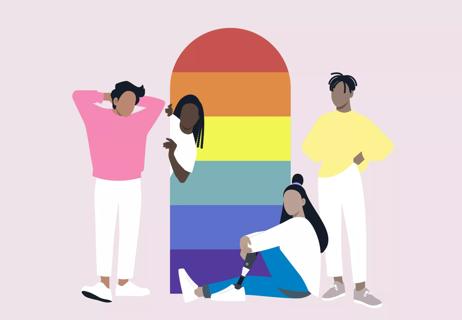Being nonbinary means not identifying solely (or at all) with being male or female

For a long time, Western society thought of sex and gender as a binary: male/female, girl/boy, man/woman. Though plenty of people throughout history have likely identified otherwise, we haven’t had the language to talk about or understand what that means.
Advertisement
Cleveland Clinic is a non-profit academic medical center. Advertising on our site helps support our mission. We do not endorse non-Cleveland Clinic products or services. Policy
Fortunately, we’ve come a long way. In 2021, a study by the Trevor Project found that more than a quarter (26%) of LGBTQIA+ youth now identify as nonbinary, with an additional 20% saying they’re still questioning whether they’re nonbinary. And that data doesn’t even begin to cover nonbinary/questioning adults.
But what exactly does it mean to be nonbinary? Child and adolescent psychiatrist Jason Lambrese, MD, helps define this term so that you can better understand this gender identity.
In simple terms, being nonbinary means that you do not identify (solely or at all) with the idea of being a man or a woman.
“We used to think that people were either male or female, and that was it — that there were two endpoints, and everyone had to be at one of them,” Dr. Lambrese says. “But it became clear that that didn’t fit everybody’s experience.”
Now, health professionals recognize that gender identity is much more expansive and multifaceted. Sometimes, it’s explained as a spectrum — a sliding scale of sorts, with “male” and “female” as endpoints.
For some people, being nonbinary means feeling that you’re somewhere else along that line — in between male and female, or a combination of some aspects of both. But other nonbinary people feel that their gender identity exists outside the male/female spectrum — not on the line but somewhere else altogether.
Advertisement
“There are a lot of cultures where it’s very common to identify as male, female or a third gender,” Dr. Lambrese notes. “We might put it somewhere in the middle of the spectrum, or it can be thought about completely outside of that construct.”
If you’re trying to get a handle on what it means to be nonbinary, you’re going to have to get comfortable in gray space: There are no specific, hard-and-fast rules about nonbinary identities or “what it means” to be nonbinary.
“What it means for one person could be different than what it means for somebody else,” Dr. Lambrese states.
A nonbinary person could just identify with the term “nonbinary,” or they may use other terms to describe themselves and their relationship (or lack thereof) with gender:
Because gender can be such a personal experience, these terms can mean different things to different people. And some people might identify with multiple terms or with others not listed here.
If these terms are new to you, you might feel confused about some of the nuances and differences between them. That’s OK. The most important thing is to remain open-minded to learning what they mean to individual people and their gender identity — so that you can be as supportive as possible.
Sometimes, and sometimes not. The answer to this question comes down to each individual person and what identity feels right to them.
For the most part, you can think of being transgender as an overarching concept that encompasses multiple types of identities. “You could say that being trans is the most overarching of all of the umbrella terms, and under that are smaller umbrellas, like being nonbinary,” Dr. Lambrese clarifies.
But not everyone who identifies as nonbinary will identify with being trans. Some nonbinary people, for example, may feel more comfortable with explanations like “not cisgender.” (Cisgender meaning people whose gender identity corresponds with what they were assigned at birth.)
“For some people, even the term ‘transgender’ can feel like a binary,” Dr. Lambrese says, “so being nonbinary may feel separate from the identity of transgender. It’s all very individualized.”
Advertisement
It’s always best not to make assumptions about anyone’s identity — which is, by the way, a good rule of thumb for all for life!
This answer differs for every person, but “they/them” is common. The Trevor Project found that more than one-third of nonbinary youth exclusively (only) use the pronouns “they/them.”
For some people, using they/them to refer to a singular person feels weird and uncomfortable — that squiggly feeling you get when you use improper grammar. If this is you, try to remember: Language is constantly evolving, and it’s OK for words’ meanings to change. Plus, you’re probably already more used to using they/them singular pronouns than you might think (for example, “Someone left their umbrella behind! I sure hope they come back for it.”).
“It’s important that we validate and normalize ’they/them’ as pronouns that can be used singularly,” Dr. Lambrese states.
The study also found that an additional 21% of respondents use a combination of gender pronouns that include but aren’t limited to they/them. This could mean, for example, that someone uses them/them pronouns and she/her pronouns. They may prefer that you mix them up at random (“I’m getting lunch with her tomorrow because they weren’t available today.”) or ask that you use certain pronouns at certain times.
Advertisement
Less common but still important are neopronouns, which are words that have been created to take the place of traditional pronouns. Some examples include:
If you’re not sure exactly how to use neopronouns, here’s an example: “Xe is so friendly and funny. When I first met xem last week, I immediately asked for xir number so we could hang out.”
It can take some work to incorporate this type of evolving language into your lexicon, but doing so shows respect and support for others. Like anything new, it will start to come naturally to you over time.
“If you mess up, that’s OK,” Dr. Lambrese reassures. “Just apologize and use the correct one going forward. People can usually appreciate that. It’s when you’re not trying that can be very hurtful.”
The English language now offers more terminology than ever for people to express their gender identity, which represents society’s evolving understanding of gender. But that doesn’t always mean that individual people have become more understanding or accepting.
The Trevor Project found that 42% of LGBTQ youth seriously considered attempting suicide in the year before the study. That included more than half of transgender and nonbinary youth — largely owing to a lack of support and respect from family, friends and society at large.
Advertisement
“When nonbinary teens live in an environment where they’re not feeling accepted or validated, they can experience negative mental health outcomes like depression, anxiety and even suicidal ideation,” Dr. Lambrese says.
The Trevor Project found that nonbinary youth whose family members respected their pronouns were far less likely to attempt suicide than their peers without family support.
“These numbers are supported by studies that have looked at sexual and gender minorities over time,” Dr. Lambrese says. “Data shows that the more support children and teens have, the better their mental health outcomes are.”
“Being affirming of somebody’s experience doesn’t have to mean that you fully understand all of the intricacies of their identity,” Dr. Lambrese says. “It doesn’t even have to mean that you agree with all of their goals for themselves. But you can still be affirming and supportive.”
Two of the simplest and more powerful ways to show your respect and support are to use people’s preferred names and proper pronouns.
“At the very least, this allows people to feel heard,” he says. “The data shows that sometimes, those simplest things lead nonbinary people to say, ‘When my pronouns are used correctly, I feel so much better.’ It’s such a simple, easy thing that we can all do.”
Dr. Lambrese shares some tips:
At the end of the day, supporting nonbinary people is, in so many ways, similar to supporting any other community of people: “Operate in good faith, demonstrate respect and apologize when you fall short,” Dr. Lambrese encourages.
Learn more about our editorial process.
Advertisement

Start with one person you trust, and then you can open the door to the rest of the world

988 updates and replaces the old suicide hotline

Our understanding of what it means to be asexual has blossomed

Find a healthcare provider who’s welcoming and affirming

It can be difficult to qualify for certain tests

Contributing factors include racial disparities, high barriers to care and more

When providing healthcare for the transgender community, there can't be a disconnect

Most recommended precautions center around minimizing bruising or swelling

Type 2 diabetes isn’t inevitable with these dietary changes

Applying a hot or cold compress can help with pain